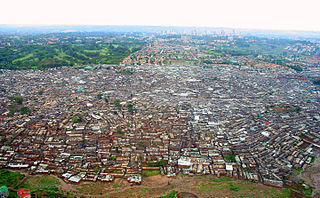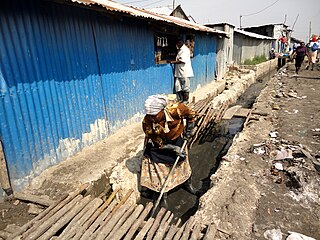Related Research Articles

A slum is a highly populated urban residential area consisting of densely packed housing units of weak build quality and often associated with poverty. The infrastructure in slums is often deteriorated or incomplete, and they are primarily inhabited by impoverished people. Although slums are usually located in urban areas, in some countries they can be located in suburban areas where housing quality is low and living conditions are poor. While slums differ in size and other characteristics, most lack reliable sanitation services, supply of clean water, reliable electricity, law enforcement, and other basic services. Slum residences vary from shanty houses to professionally built dwellings which, because of poor-quality construction or lack of basic maintenance, have deteriorated.

Kibera is a division and neighbourhood of Nairobi, Kenya, 6.6 kilometres (4.1 mi) from the city centre. Kibera is the largest slum in Nairobi, and the largest urban slum in Africa. The 2009 Kenya Population and Housing Census reports Kibera's population as 170,070, contrary to previous estimates of one or two million people. Other sources suggest the total Kibera population may be 500,000 to well over 1,000,000 depending on which slums are included in defining Kibera.
Slum/Shack Dwellers International (SDI), is a global social movement of the urban poor that started in 1996. It forms a network of community-based organisations in more than 30 countries across Africa, Asia, Latin America and the Caribbean.
South B is the name of a Division of the sub-county of Starehe in Nairobi, Kenya and the name of a "sub-location" of Mukuru Nyayo within the Division. The 2019 Kenya Census gives a population of 102,441 for South B Division and 34,216 for the sub-location. South B is about 3 kilometres (1.9 mi) south-east of Nairobi Central Business District; the Industrial Area lies to the east and the South C district to the south-west.

Mukuru Kwa Njenga is a slum in the Mukuru slums of Nairobi. Mukuru kwa Njenga is among other villages in Mukuru namely; Mukuru kwa Reuben, Mukuru kwa Njenga, Sinai, Paradise, Jamaica, Kingstone, Mariguini, Fuata Nyayo and Kayaba. The population exceeds 100,000.
Laini Saba is a slum of Nairobi, the capital of Kenya. It belongs to the major slum of Kibera. As for Lindi, another village within Kibera, its population is estimated at 100,000. Soweto East is another village belonging to Kibera. The price of water there clearly is above Nairobi average. A Laini Saba Primary School exists.
Lindi is a suburb of Nairobi, the capital of Kenya. It belongs to the major slum of Kibera. As for Laini Saba, another village within Kibera, its population is estimated at 100,000. Soweto East is another village belonging to Kibera. The price of water there clearly is above Nairobi average. A Lindi Friends Primary School exists.
Gatwekera (Gatuikira) is a part of Kibera slum in Nairobi. Its population likely exceeds 70,000. Water & Sanitation for the Urban Poor is active there. Many of its residents are Luo. Médecins Sans Frontières used to run a health center there. Other parts of Kibera include Laini Saba, Lindi, Makina, Kianda, Mashimoni, Soweto East, Kisumu Ndogo and Siranga.
Kisumu Ndogo is a name given to "villages" that are part of two informal settlements in Nairobi, Kenya, Kibera and Korogocho. Kisumu Ndogo means little Kisumu. Most dwellers of these villages are believed to be of low income. Nowadays, there are many villages across the country called Kisumu Ndogo. for example, there are in fact two Kisumu Ndogo villages in Kilifi county alone, one in Malindi sub county and one in Kilifi North sub county. There is also one in Mombasa and Nakuru Counties.
Mashimoni is a part of Kibera slum in Nairobi. Mashimoni Primary School, Facing the Future School, Mashimoni Good Samaritan School for the Orphans (MAGOSO) and Mashimoni Squatters Schools exist. Many of its residents are Luhyas and Kambas. It is part of Langata Constituency. Other parts of Kibera include Laini Saba, Lindi, Makina, Kianda, Gatwekera, Soweto East, Kisumu Ndogo and Siranga.
Siranga is a part of Kibera slum in Nairobi. Its population is estimated at 150,000 residents. The Nairobi Christian Outreach Centre is in Siranga. Other parts of Kibera include Laini Saba, Lindi, Makina, Kianda, Gatwekera, Soweto East, Kisumu Ndogo, Mugumoini, Makongeni, Kichinjio and Mashimoni.
Mugumoini is a part of Kibera slum in Nairobi. A Mugumoini Primary School exists. It is part of Langata Constituency. Many residents are Luhyas. Mugumoini has a PCEA church. Other parts of Kibera include Laini Saba, Lindi, Makina, Kianda, Gatwekera, Soweto East, Kisumu Ndogo, Makongeni, Kichinjio and Mashimoni.
Kichinjio is a part of Kibera slum in Nairobi. Kichinjio has a New Adventure Secondary School and a Kicoshep Primary School. Furthermore, Kichinjio has a mosque. Other parts of Kibera include Laini Saba, Lindi, Makina, Kianda, Gatwekera, Soweto East, Kisumu Ndogo, Makongeni and Mashimoni.
Sarang'ombe is a part of Kibera in Nairobi.Some parts of Sarang'ombe ward include Ayany Estate. It is part of Kibra Constituency. An Ushirika Health Centre is in Sarang'ombe. Other parts of Kibera include Laini Saba, Lindi, Makina, Kianda, Gatwekera, Soweto East, Kichinjio, Kisumu Ndogo, Makongeni and Mashimoni.
Shilanga is a part of Kibera slum in Nairobi. It has at least one church. It has a major Luo population. Other parts of Kibera include Laini Saba, Lindi, Makina, Kianda, Gatwekera, Soweto East, Kichinjio, Kisumu Ndogo, Makongeni and Mashimoni.
Anita Reddy is an Indian social worker from Karnataka and the founder of Association for Voluntary Action and Services (AVAS), known for her services for the rehabilitation and upliftment of the slum dwellers in Karnataka and Andhra Pradesh. She is the managing trustee of DWARAKA and DRIK Foundations, working for children's education and women's livelihoods. The Government of India honored Anita Reddy in 2011, with the fourth highest civilian award of Padma Shri.

Mukuru is a collection of slums in the city of Nairobi. It is approximately 7 kilometres (4.3 mi) south of the central business district of Nairobi. It is one of the largest slums in Nairobi. It stretches along the Nairobi–Ngong River, situated on waste lands in the industrial area of the city between the Outering Ring Road, North Airport Road and Mombasa Road. Mukuru is among other major slums in Nairobi such: Korogocho, Kibera and Mathare.

The Muungano Party (MP) is a political party in Kenya.
Nyayo Highrise is a residential neighbourhood in the city of Nairobi. It is approximately 3.5 kilometres (2.2 mi) southwest of the central business district of Nairobi. Initially a slum upgrading project, the estate was built in an effort by the national government to provide its citizens with affordable housing.

Muungano wa Wanavijiji, was formed in the slums of Nairobi in 1996, to represent the rights of slum dwellers. By 2000, it was nationwide and the following year it affiliated with Slum Dwellers International (SDI). The group aims to improve conditions for its members in terms of housing, sanitation and water, whilst also engaging in citizenship debates and resisting evictions. By 2014, it had set up over 100 savings funds serving 25,000 members in nine different cities through its financial wing Akiba Mashinani Trust (AMT).
References
- 1 2 "VF Proposal: Schooling for Children in Matopeni, Kenya". Archived from the original on 2010-12-10. Retrieved 2010-08-15.
- ↑ Lines, Kate; Makau, Jack (2017). Muungano nguvu yetu (unity is strength) 20 years of the Kenyan federation of slum dwellers (PDF). IIED.
- ↑ "Who Owes Matopeni Settlement an Explanation? - Slum Dwellers International". SDI. 23 January 2013. Retrieved 22 April 2024.